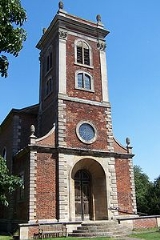
Willen
Overview
Milton Keynes
Milton Keynes , sometimes abbreviated MK, is a large town in Buckinghamshire, in the south east of England, about north-west of London. It is the administrative centre of the Borough of Milton Keynes...
, England
England
England is a country that is part of the United Kingdom. It shares land borders with Scotland to the north and Wales to the west; the Irish Sea is to the north west, the Celtic Sea to the south west, with the North Sea to the east and the English Channel to the south separating it from continental...
and is also one of the ancient village
Village
A village is a clustered human settlement or community, larger than a hamlet with the population ranging from a few hundred to a few thousand , Though often located in rural areas, the term urban village is also applied to certain urban neighbourhoods, such as the West Village in Manhattan, New...
s of Buckinghamshire
Buckinghamshire
Buckinghamshire is a ceremonial and non-metropolitan home county in South East England. The county town is Aylesbury, the largest town in the ceremonial county is Milton Keynes and largest town in the non-metropolitan county is High Wycombe....
to have been included in the designated area of the New City in
1967
History of Milton Keynes
Milton Keynes is a large town in South East England, founded in 1967. This history of Milton Keynes details its development from the earliest human settlements, through the plans for a 'new city' for 250,000 people in south central England, its subsequent urban design and development, to the...
. The original village is now a small but important part of the larger district that contains it and to which it gives its name.
The tiny parish church (1680) at Willen was designed by the architect and physicist Robert Hooke
Robert Hooke
Robert Hooke FRS was an English natural philosopher, architect and polymath.His adult life comprised three distinct periods: as a scientific inquirer lacking money; achieving great wealth and standing through his reputation for hard work and scrupulous honesty following the great fire of 1666, but...
and is a classic of the early English Baroque
English Baroque
English Baroque is a term sometimes used to refer to the developments in English architecture that were parallel to the evolution of Baroque architecture in continental Europe between the Great Fire of London and the Treaty of Utrecht ....
period.
Further around the lake, there is a Buddhist Temple/monastery
Monastery
Monastery denotes the building, or complex of buildings, that houses a room reserved for prayer as well as the domestic quarters and workplace of monastics, whether monks or nuns, and whether living in community or alone .Monasteries may vary greatly in size – a small dwelling accommodating only...
and a large stupa
Stupa
A stupa is a mound-like structure containing Buddhist relics, typically the remains of Buddha, used by Buddhists as a place of worship....
, a Peace Pagoda
Peace Pagoda
A Peace Pagoda is a Buddhist stupa designed to provide a focus for people of all races and creeds, and to help unite them in their search for world peace. Most have been built under the guidance of Nichidatsu Fujii , a Buddhist monk from Japan and founder of the Nipponzan-Myōhōji Buddhist Order...
built in 1980 by the Monks and Nuns of the Nipponzan-Myōhōji
Nipponzan-Myohoji
Nipponzan Myōhōji , founded in 1917 by Nichidatsu Fujii, is a new religious movement that emerged from the Nichiren sect of Japanese Buddhism....
.
Unanswered Questions

